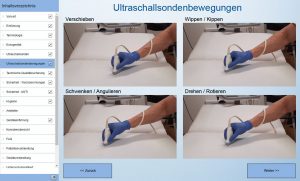Design, development, and evaluation of interactive e-learning content in sonography education for medical and radiological technology students
Aim and Research Question(s)
The main goal of this thesis was to evaluate the value of the Massive Open Online Course (MOOC) prototype (see https://m3e.meduniwien.ac.at/lp/Sonotechnik/) in abdominal sonography at providing information for medical and radiological technology students.
Background
Ultrasound is getting more and more popular these days due to its accessibility, availability, low cost compared to other radiological modalities and lack of ionizing radiation [1]. But a successful ultrasound examination depends on the operator and his or her skill. Due to a lack of time, space and budgetary restraints, students are often not able to learn and practice sonographic procedures to a satisfying extent during their studies [2].
Methods
The thesis included a literature research about the current state of the art in educational models, the development of ultrasound skills and e-learning content. Based on the literature research, the content of the MOOC was supervised by an EFSUMB expert and created (exemplary in Figure 1), followed by semi-structured interviews, based on Nielsen and Molich’s research. The interview outcomes were evaluated with the severity-scale approach by Nielsen [3-4].
 Figure 1: Slide of Ultrasound transducer hand movements
Figure 1: Slide of Ultrasound transducer hand movements
Results and Discussion
All twelve participants were able to complete the test according to the guideline without any intervention or assistance, which suggests sufficient usability overall. The severity of the issues identified by the participants was evaluated utilizing the scale of severity rating for usability problems designed by Nielsen [3]. One minor, one major and no usability catastrophes were identified, which further confirms the assumption that the MOOC exhibits satisfactory usability.
Conclusion
The test users and a study by Tsankov et al. [5] mentioned not only higher learner achievements, but also their positive attitudes towards learning. Test users also support the findings of the previously mentioned study by Beaulieu et al. [6] that web-based education, combined with a structured curriculum, can result in improved performance in ultrasound examinations compared to traditional face-to-face instruction. The possibility of online education with MOOCs during social distancing times of a pandemic was also highly appreciated by the participants. However, interactivity was the main reason addressed by the test users in the interview. Interactivity was described as the main motivating factor.
References
[1] J. Andrés et al., “The FAST and extended FAST examinations”, 2015 [2] C. Kollmann, “Vermittlung technischer Grundlagen bei der studentischen Ultraschallausbildung”, 2018 [3] J. Nielsen, “Severity Ratings for Usability Problems”, 1995 [4] J. Nielsen and R. Molich, “Improving a Human-Computer Dialogue”, 1990 [5] S. Tsankov et al., “Research of the impact of interactive educational multimedia on student’s motivation to study different informatics disciplines”, 2016 [6] Y. Beaulieu et al., “Bedside ultrasound training using web-based e-learning and simulation early in the curriculum of residents”, 2015
